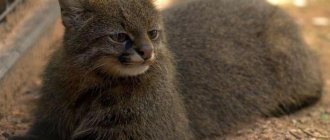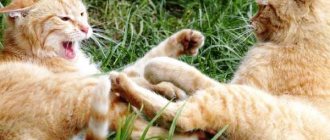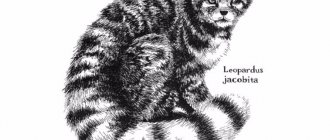Description
The Kalimantan cat is one of the rarest and least studied members of the cat family (Felidae) in the world. The Borneo cat has the size of a large domestic cat, but with a relatively long body and tail, and rounded ears located on the sides of the head, giving it an unusual appearance for a wild cat.
There are two main colors of the Kalimantan cat: gray-black and red-brown, although the second option is more common. The coloration of this species is relatively uniform over the entire back and sides, but tends to be lighter on the underbelly, chest and chin. Two faint brown stripes can be seen on the Borneo cat's cheeks, while the back, belly and limbs are covered with pale black speckles or spots. The hair on the back of the head, cheeks and front of the throat grows forward rather than backward.
The Kalimantan cat has very specific markings on its face, including pale brown spots on the sides of the mouth and pale markings on the inside of the upper eyelids. There are M-shaped markings on the back of the head, and the top of the head is dark grayish brown. The ears of the Borneo cat are black-brown on the outside and lighter on the inside, and the long tail becomes narrower towards the end and has a white stripe below, from the middle to the tip.
There is practically no data on the mass of Kalimantan cats, since weighings were carried out only with individuals who had been in captivity for a long time, and may differ greatly from the indicators in the wild.
Dimensions
- Male body length: 45.5-67 cm;
- Female body length: 45.2-62 cm;
- Male tail length: 32.5-38.5 cm;
- Female tail length: 32-40.3 cm;
- Approximate weight: 3-4 kg.
Life in captivity
The cat lives only in nature reserves, but so far without offspring . But practically nothing is known about such an animal’s life. The fact is that these cats are not bred in captivity and in most cases die after being captured.
One of my friends visited one of the reserves in Borneo, where the Kalimantan cat lives. However, the territory of the reserve is vast, and this animal does not like to show itself to people. Perhaps that is why my friend had to appreciate the beauty of nature more than the modest wild cat. But she also liked this activity and her friend did not regret it at all, despite the fact that she never saw the treasured animal.
Habitat
Initially, the Borneo cat lived only in densely forested areas. However, recently the species has been observed along river banks and close to other watercourses, with local fishermen present in large numbers.
In addition, it has been suggested that the Kalimantan cat leads an arboreal lifestyle, as it has been seen on the lower branches of trees more than once. This theory is supported by the presence of a long tail and body that are ideal for climbing, but this is just a guess. Sightings of the Borneo cat are very rare and are often based on the memories of local residents, making data on the exact habitat of this species not very reliable.
Diet
The Borneo cat is a bold and energetic predator. Its main diet is rodents (rats, mice). Can catch birds, squirrels, insects, reptiles and amphibians, small monkeys.
At the wrong time, he does not disdain carrion. The secretive lifestyle of animals does not give scientists the opportunity to observe them in nature, so all information was obtained on the basis of the available remains.
Security status
The Kalimantan cat is classified as an endangered species (EN) on the IUCN Red List and is listed on Appendix II of CITES (the Convention on International Trade in Endangered Species of Plants and Animals).
There is legal protection for the Kalimantan cat on the island of Borneo, but enforcement of the laws is poor and has done little to stop the trade in these wild cats.
Suggestions for conservation of the Borneo cat include: studying the animals in captivity, reducing habitat destruction, and conducting research to increase knowledge about the exact range and habitat of the species. In addition, recommendations have been made for the establishment of captive breeding programs for Kalimantan cats to increase the population size of this elusive species.
Temminck's cat
Temminck's cat (Catopuma temminckii).
Temminck's cat lives in the tropical forests of Southeast Asia. These cats live alone and are quite shy animals. They are nocturnal, can climb trees well, but nevertheless move mainly on the ground. Their prey includes mice, hares, young deer and birds.
Key Facts
- Fewer than 25 Borneo cats have been studied by scientists, making them one of the rarest and least studied felines in the world.
- The Kalimantan cat looks quite unusual for a wild cat, as it is the size of a large domestic cat and has a relatively long tail.
- There are two color variations of the Borneo cat: red-brown (the most common) and gray-black.
- Almost nothing is known about the species' preferred habitats, but Kalimantan cats are most often observed in dense forest and along watercourses.
Character traits
The Kalimantan cat has dense and shiny fur. Its color varies from gray-brown to golden-red. There are random dark spots on the body. The neck, chin and lower body are slightly lighter than the main part. During the cold season, these places turn white.
The Borneo is no larger in size than domestic cats. All body proportions are slightly elongated and elongated. The height of the individual does not exceed 35 cm, and the weight is limited to 5 kg.
Externally, the Kalimantan cat looks like this:
- The head is proportional, round in shape, the muzzle is slightly extended forward.
- The eyes are grey-green, large and expressive.
- The ears are small with rounded ends and are very sensitive and pick up any subtle sounds.
- The neck is mobile and well covered with muscles.
- The body is muscular, strong, quite strong.
- Tail – is a distinctive feature of the Kalimantan cat, it is long, ends with a small hook, there is a black dot at its tip, and occupies more than half of the total length of the body. It helps balance during movements.
All representatives of the breed are distinguished by grace, flexibility, patience and swift attack. All these qualities make the cat a dangerous opponent. Despite its attractive and harmless appearance, the Borneo cat is distinguished by its rare ferocity and aggressiveness. Any attempts to catch her end in a fight. Its small size does not prevent it from offering fierce resistance.
Sometimes representatives of this species can be confused with other animals, for example, with Temminck's cat. They belong to the same genus Catopuma. But the inhabitants of the island of Borneo have their own distinctive features:
- smaller size;
- unique dental system.
All this makes the species interesting to study. Individuals easily move in dense grass, climb trees and look for prey. They can track a hunting object for a long time and monitor it.
Pampas cat
Pampas cat (Leopardus pajeros).
It is found on the grassy plains of South America, among shrubs, open forests, and occasionally in the floodplains of the Brazilian pantanal and in the semi-arid cold deserts of Patagonia. In the high Andes, although the species has been seen at altitudes above 5,000 m, most records are from lower altitudes. The Pampas cat hunts rodents, birds, as well as lizards and large insects.
Sumatran cat
Sumatran cat (Prionailurus planiceps).
A wild cat native to Thailand, Peninsular Malaysia, Indonesia, Sumatra and Borneo. This species feeds on fish, frogs and other aquatic animals. Seen in raids on poultry. They dig up the ground in search of edible roots and also eat fruits. This species of cat is rare, its total number is unknown.
Kalimantan cat: Zombie cat back from the dead
Frost
“Zombie Cat Back from the Dead” sounds like the title of a stupid B-movie, except in the impenetrable jungle of Borneo
the magic of resurrection really happens.
Among the impenetrable swamps and dense thickets of the jungle, she meets you with her sparkling gaze - the Kalimantan cat
.
To imagine a tropical Murka, just stretch your domestic cat a few centimeters in length and dye the fur in golden-red shades
and add
a giant tail
.
Add to this beauty the creepiest facial expression you can imagine and voila - the Kalimantan cat is ready! Isn't she a beauty? It’s a pity that it died out back in 1920
...
Have you already felt a chill running down your spine? Don’t worry, what you see is not paranormal, now we will explain everything.
The animal was discovered back in 1895
.
Even then, the cat, don’t be a fool, had no desire to meet people, carefully hiding in the forests. In order to pump up the level of camouflage to the maximum, the Kalimantan cat needed 25 years
.
Year after year, the animal came into the field of view of people less and less often. And in 1920 it disappeared completely
, which is why scientists considered it extinct!
The Kalimantan cat lived under the status of anonymity for many years. Pussy spent 70 years in the black book
!
All this time, scientists had no choice but to study the animal using bones and remaining skins
.
But in 1992
, our friend literally
rose from the dead
!
Zoologists owe the “discovery” of the Kalimantan cat, oddly enough, to poachers. An adult female was caught in one of the traps they set. This is 1 of 2 cases of homo sapiens meeting a living representative of the species
!
The second meeting took place not so long ago, in 2011
.
The found animal was assigned to the Pulong-tau
, where the herd lives to this day.
All that is known about the life of a pussy is that it is secretive
.
Even the estimated number ranges from a couple of hundred to 2.5 thousand
.
But the power of technological progress will not allow the resurrected cat to “disappear” again! Thanks to camera traps, scientists monitor the activity of
ninja cats and piece by piece collect knowledge about their lifestyle and behavior.
Only one thing is known for sure: the Kalimantan cat hates people
.
Despite the fact that the dimensions of the animal differ little from the parameters of our domestic pussies, the animal is ready to tear into pieces the sapiens that have bothered it at the first opportunity
. And, I must say, she has good reasons for this.
First, people are destroying its habitat.
.
An animal deprived of hunting grounds is doomed to constant clashes between relatives or starvation
.
Secondly
, despite the fact that the furry ninja managed to hide from people for 70 years,
poachers successfully find and catch the animal
.
The uniqueness of the Kalimantan cat became its curse. At the bird market for wealthy people, a wild cat is sold for $10,000
.
Needless to say, caught animals die in agony from inappropriate conditions of detention
in the houses of their rich owners? Needless to say, the love of expensive show-offs once again threatens an endangered species?
Well, it’s not for nothing that the animal has been hiding from us for decades. It’s better to die out in pretend than for real.
Please like if you liked the cat.
Subscribe if you are interested in reading about animals. You can talk in the comments.
Bye!
Source:Go
Share
Origin story
The Kalimantan or Borneo cat, as the name implies, has long lived on the island of Kalimantan (Borneo), which belongs to Indonesia and Malaysia. Its existence first became known in 1885 from the British geographer, biologist and naturalist Alfred Russell Wallace, who was the first to describe the skin of a killed animal. Until the end of the twentieth century, scientists studied the structure of this cat only from skins, bones and skulls.
The first living specimen was caught in 1992 by the local population. Until this time, the Kalimantan cat was classified as an extinct species.
After another such predator was caught alive in 1998, scientists began research seriously. Cameras were installed in the jungles of the Lanjak-Entimau Natural Park and since then the Borneo cat caught in the lens has become the subject of increased attention of zoologists. However, observations of them are extremely rare - the animals lead a secretive lifestyle, and the kittens are hidden in secluded places where neither technology nor humans can reach.
Chinese cat
Chinese cat (Felis bieti).
A species of cat family found mainly in China. This cat is slightly larger than a domestic cat, and at first meeting it seems like an enlarged specimen of a wild European cat, they are so similar. Its size and weight also resembles a jungle cat (however, the legs of a Chinese cat are shorter).











